Intel Announces 12th Gen Core Alder Lake: 22 New Desktop-S CPUs, 8 New Laptop-H CPUs
by Dr. Ian Cutress on January 4, 2022 1:10 PM EST
When Intel launched its 12th Generation Core family of processors late last year, it was only a small set of overclockable parts for desktops that came to market. Featuring Intel’s new hybrid core design, the hardware proved competitive and cost effective, making it a very interesting time to be a consumer. However, the main battle for volume sales is typically in the mid-range and notebook segments which power millions of devices, and Intel is launching these processors today. These include the 35 W and 65 W desktop processors, new desktop coolers, and a handful of 45W+ laptop offerings for the creator and gaming markets.
New Desktop CPUs: Hardware for the Masses
While all the glitz and the glamour goes to the high-profile overclockable processors in any given generation, the bulk of Intel’s sales actually comes from the standard, run-of-the-mill hardware that gets put into the majority of commercial and pre-built hardware. To that end, Intel usually releases anywhere from 10 to 50+ new desktop processors to fill in the markets where needed. These processors usually come from anything up to four base physical designs, and parts of those chips are disabled depending on yield or market demand and sold accordingly.
For Alder Lake, Intel is launching 22 new desktop processors, from $42 dual core Celerons at 35W all the way up to $489 Core i9-12900 parts. The full stack, including the overclockable processors, now looks like this:
| Intel 12th Gen Core, Alder Lake | ||||||||||
| AnandTech | Cores P+E |
E-Core Base |
E-Core Turbo |
P-Core Base |
P-Core Turbo |
L3 MB |
IGP | Base W |
Turbo W |
Price $1ku |
| Core i9 | ||||||||||
| i9-12900K | 8+8 | 2400 | 3900 | 3200 | 5200 | 30 | 770 | 125 | 241 | $589 |
| i9-12900KF | 8+8 | 2400 | 3900 | 3200 | 5200 | 30 | - | 125 | 241 | $564 |
| i9-12900 | 8+8 | 1800 | 3800 | 2400 | 5100 | 30 | 770 | 65 | 202 | $489 |
| i9-12900F | 8+8 | 1800 | 3800 | 2400 | 5100 | 30 | - | 65 | 202 | $464 |
| i9-12900T | 8+8 | 1000 | 3600 | 1400 | 4900 | 30 | 770 | 35 | 106 | $489 |
| Core i7 | ||||||||||
| i7-12700K | 8+4 | 2700 | 3800 | 3600 | 5000 | 25 | 770 | 125 | 190 | $409 |
| i7-12700KF | 8+4 | 2700 | 3800 | 3600 | 5000 | 25 | - | 125 | 190 | $384 |
| i7-12700 | 8+4 | 1600 | 3600 | 2100 | 4900 | 25 | 770 | 65 | 180 | $339 |
| i7-12700F | 8+4 | 1600 | 3600 | 2100 | 4900 | 25 | - | 65 | 180 | $314 |
| i7-12700T | 8+4 | 1000 | 3400 | 1400 | 4700 | 25 | 770 | 35 | 99 | $339 |
| Core i5 | ||||||||||
| i5-12600K | 6+4 | 2800 | 3600 | 3700 | 4900 | 20 | 770 | 125 | 150 | $289 |
| i5-12600KF | 6+4 | 2800 | 3600 | 3700 | 4900 | 20 | - | 125 | 150 | $264 |
| i5-12600 | 6+0 | - | - | 3300 | 4800 | 18 | 770 | 65 | 117 | $223 |
| i5-12600T | 6+0 | - | - | 2100 | 4600 | 18 | 770 | 35 | 74 | $223 |
| i5-12500 | 6+0 | - | - | 3000 | 4600 | 18 | 770 | 65 | 117 | $202 |
| i5-12500T | 6+0 | - | - | 2000 | 4400 | 18 | 770 | 35 | 74 | $202 |
| i5-12400 | 6+0 | - | - | 2500 | 4400 | 18 | 730 | 65 | 117 | $192 |
| i5-12400F | 6+0 | - | - | 2500 | 4400 | 18 | - | 65 | 117 | $167 |
| i5-12400T | 6+0 | - | - | 1800 | 4200 | 18 | 730 | 35 | 74 | $192 |
| Core i3 | ||||||||||
| i3-12300 | 4+0 | - | - | 3500 | 4400 | 12 | 730 | 60 | 89 | $143 |
| i3-12300T | 4+0 | - | - | 2300 | 4200 | 12 | 730 | 35 | 69 | $143 |
| i3-12100 | 4+0 | - | - | 3300 | 4300 | 12 | 730 | 60 | 89 | $122 |
| i3-12100F | 4+0 | - | - | 3300 | 4300 | 12 | - | 58 | 89 | $97 |
| i3-12100T | 4+0 | - | - | 2200 | 4100 | 12 | 730 | 35 | 69 | $122 |
| Pentium + Celeron | ||||||||||
| G7400 | 2+0 | - | - | 3700 | - | 6 | 710 | 46 | - | $64 |
| G7400T | 2+0 | - | - | 3100 | - | 6 | 710 | 35 | - | $64 |
| G6900 | 2+0 | - | - | 3400 | - | 4 | 710 | 46 | - | $42 |
| G6900T | 2+0 | - | - | 2800 | - | 4 | 710 | 35 | - | $42 |
Split down, here’s what all the Core names mean:
- Core i9: 8 Performance Cores + 8 Efficiency Cores
- Core i7: 8 Performance Cores + 4 Efficiency Cores
- Core i5: Either 6P+4E, or 6P only
- Core i3: 4 Performance Cores only
- Pentium: 2 Performance Cores only
- Celeron: 2 Performance Cores only
Just putting Core i5 aside for a split second, what we have here is a scale of hardware that changes in performance cores, but only a select few have efficiency cores. This is because Intel is using two base physical designs for this hardware: either a large 8P+8E chip or a smaller 6P only chip. The smaller chip makes the economics of the lower core count processors work out better, but it does mean that one of the key features for Alder Lake, the hybrid CPU, will be limited to the high-end hardware only.
The Core i5 hardware is a bit odd in the middle, as the i5-12600K/KF processors use the large chip, while everything else in the Core i5 family uses the smaller chip with no efficiency cores. As a result we see some Core i5 parts with 20 MB of L3 cache, and some only with 18 MB. It’s going to be interesting to see how much those efficiency cores and extra cache brings to the table when it comes to performance and performance per dollar.
As with previous processor launches from Intel, anything with an F means that it does not have integrated graphics, and anything with a T means a 35 W base power. Because Intel readjusted how it presents turbo power for this generation (something we’re really glad Intel did), we can see that the top Core i9-12900T has a base power of 35 W and a turbo power of 106 W. In previous generations, that second number was obfuscated in technical documents, so it’s good to see it out in the open.
All the processors here support DDR5-4800 and DDR4-3200 memory, along with 16 PCIe 5.0 lanes and 4 PCIe 4.0 lanes. In order to provide a cost-effective platform for these processors, Intel is also launching new motherboard chipsets.
To date Intel launched the Z690 motherboards, but today we also get H670, B660, and H610 offerings. As with previous generations, these budget designs start cutting away at what is offered, all the way down to H610 which only supports one memory channel, PCIe 3.0 only, only four SATA ports, and no USB 3.2 Gen 2x2 ports.
Update: Intel has adjusted the slide - H610 supports two memory channels, but only one DIMM per channel.
It’s worth noting that H670 and B660 differ in two key aspects that some users will care about. B660 is the lower grade, with half the CPU-to-chipset bandwidth, and only four SATA ports. For users looking at more than a single PCIe M.2 storage drive, or multiple SATA drives, there may be an instance where the chipset link becomes a bottleneck, so watch out for that. Normally the B-series chipset is cheaper for motherboard manufacturers to use, so it will be interesting to see how the vendors split their offerings.
Alongside CPUs and motherboards, Intel is refreshing its stock CPU coolers for the first time in a long time. It has been hard not to notice how much success AMD has had with its in-box coolers, offering a $30-$50 add-on for free that is actually half decent - Intel has somewhat neglected this. But that changes today with the new Intel Laminar coolers. These coolers will come with all 65 W base power boxed Alder Lake processors.
The Core i9 parts, which have turbo powers up to 202 W, will get the Laminar RH1. This comes with RGB lighting, a larger-than-standard copper core, and ‘near silent’ performance. The connectors onto the motherboard involve screws and a backplate.
The Core i3, i5, and i7 parts, which have turbo powers up to 180 W, will get the RM1 coolers. These are more standard Intel size in height, uses the more traditional Intel push-pin arrangement. No RGB here, but a push for ‘quiet performance’. Intel doesn’t state if there is copper or an all-aluminium design.
The Pentium and Celeron parts, which don’t have turbo and are listed at 46 W, get the RS1 cooler. It has simpler design, likely all-aluminium, but a new fin arrangement with that new Intel logo. There’s no pretense here about RGB or noise, given it’s built for the cheap end of the market.
These new Alder Lake processors are expected to be available at retail this week, along with the new motherboards and coolers.
Notebooks for Alder Lake: H-Series
On the mobile side of Intel’s portfolio, the company splits its offering into different elements based on the market: U-series goes up to 15 W for modern thin and light designs, P-series up to 28 W enables something faster and more premium, and the H-series starting at 45W go for combined CPU+discrete GPU gaming and workstation designs. Today Intel is launching the H-series part of the portfolio, built on a base 6P+8E silicon design.
With Alder Lake-H, Intel is reintroducing its Hybrid CPU design to the laptop market. This means Intel’s latest high performance Golden Cove P-cores and high efficiency Gracemont E-cores, all built on the Intel 7 manufacturing process. Inside the H-series CPU includes the cores, a full 96 EUs of Intel Xe-LP graphics, support for up to four Thunderbolt 4 ports, memory support for DDR5, LPDDR5, DDR4, and LPDDR4X, and an array of PCIe, USB, and wireless connectivity options. Intel’s big win here for this generation is combining both the CPU and the chipset onto one package for its 45 W processors, rather than relying on a mobile chipset.
On the processor offerings, Intel has 8 models to showcase.
| Intel 12th Gen Core, Alder Lake-H | |||||||
| AnandTech | Cores P+E |
E-Core Base |
E-Core Turbo |
P-Core Base |
P-Core Turbo |
Base W |
Turbo W |
| i9-12900HK | 6+8 | 1800 | 3800 | 2500 | 5000 | 45 | 115 |
| i9-12900H | 6+8 | 1800 | 3800 | 2500 | 5000 | 45 | 115 |
| i7-12800H | 6+8 | 1800 | 3700 | 2400 | 4800 | 45 | 115 |
| i7-12700H | 6+8 | 1700 | 3500 | 2300 | 4700 | 45 | 115 |
| i7-12650H | 6+4 | 1700 | 3500 | 2300 | 4700 | 45 | 115 |
| i5-12600H | 4+8 | 2000 | 3300 | 2700 | 4500 | 45 | 95 |
| i5-12500H | 4+8 | 1800 | 3300 | 2500 | 4500 | 45 | 95 |
| i5-12450H | 4+4 | 1500 | 3300 | 2000 | 4400 | 45 | 95 |
At the top is the Core i9-12900HK, the K meaning that the chip is overclockable. Actually the naming for this generation is easy enough to follow: Core i9 and Core i7 have 6P cores, while the Core i5 has 4P cores. Everything has 8E cores, unless the fourth and fifth digit is a 50, e.g. i7-12650H. You may think I’m joking when I say this is easier to understand than previous generations, but trust me when I say it is. Not perfect, but easier.
Intel says it has over 100 designs using Alder-H in the pipeline from all of its major partners, all the way from 35W portable up to 65W+ halo enthusiast. On the performance side at that high-end, Intel is claiming up to +28% better gaming performance at 1080p High compared to the last generation and the competition, as well as anything up to +44% on content creation. This includes comparisons against the M1 Max.
We’re expecting to see a large number of these notebooks be announced this week, so keep your eyes peeled for that. It’s a little odd to not see Intel launch Alder-P or Alder-U, especially as it looks like Alder-U will be a 2P+8E configuration, whereas we can get Zen-U systems with 8P cores. That’ll be an interesting comparsion.


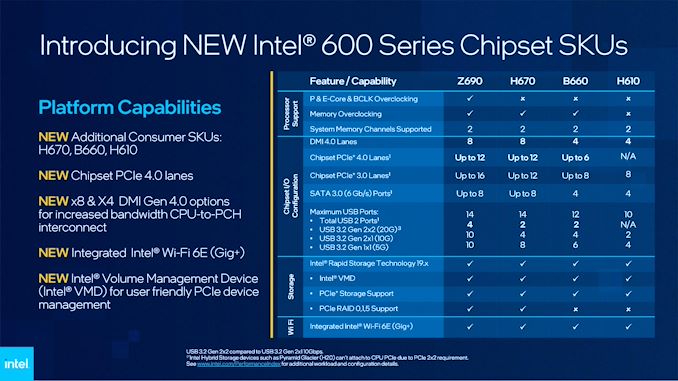
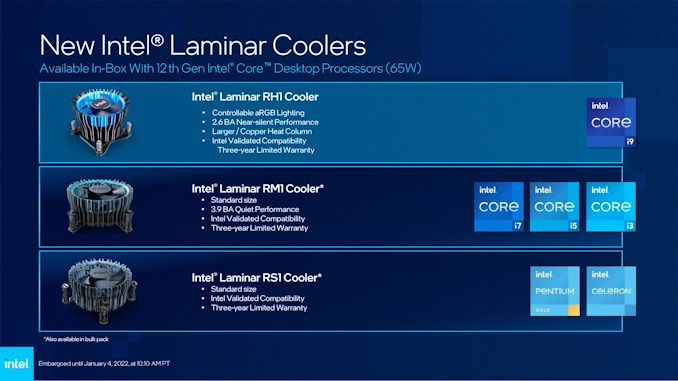
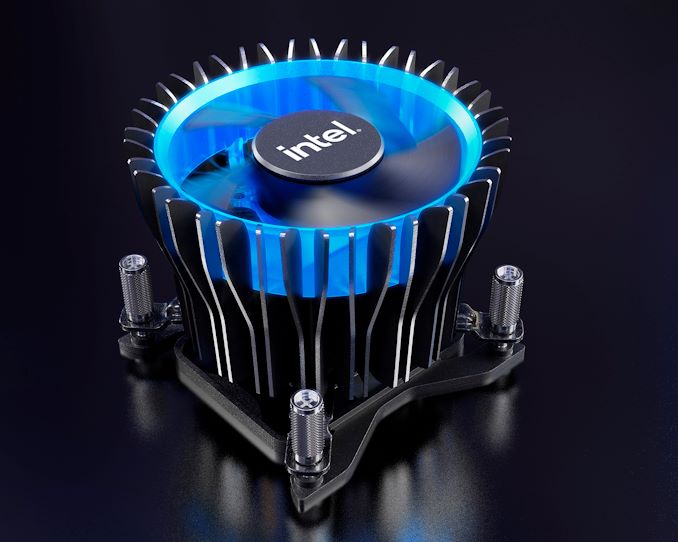
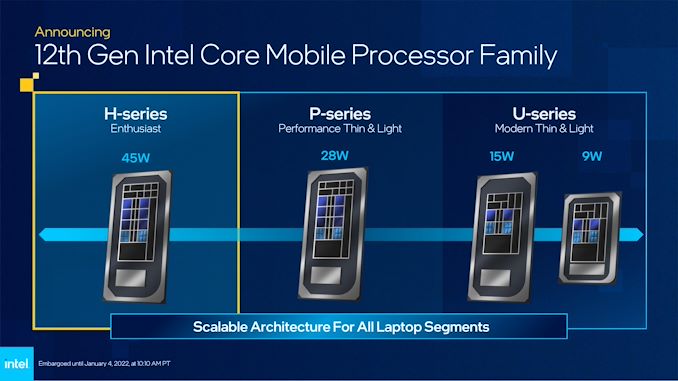
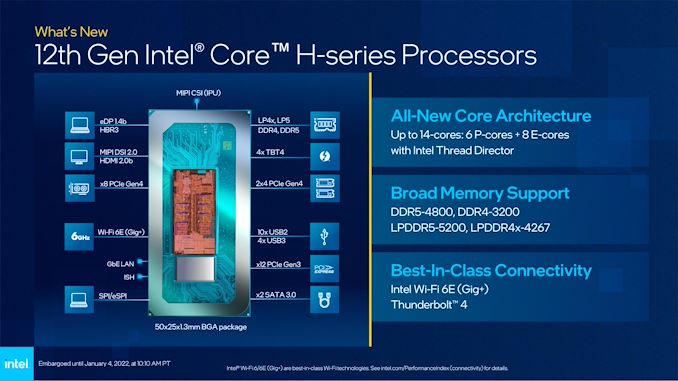
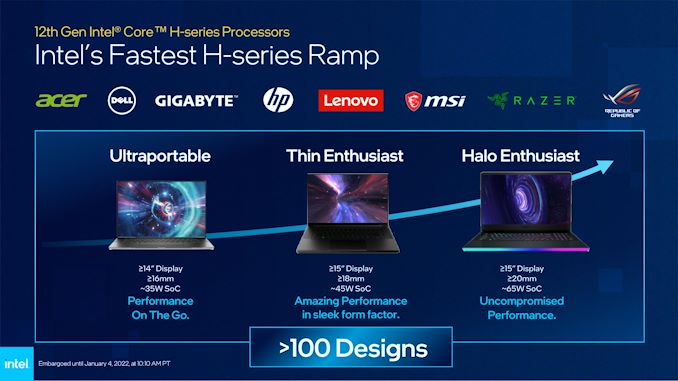
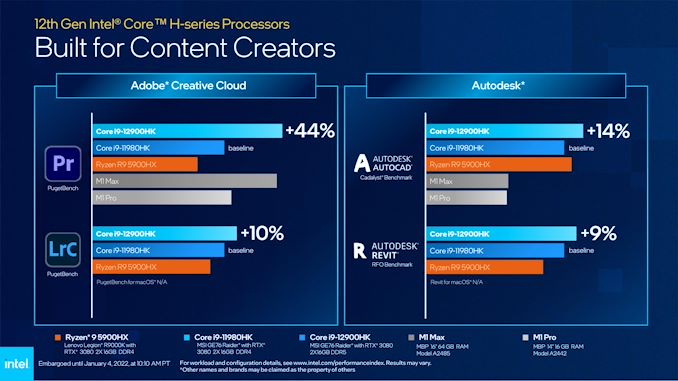








101 Comments
View All Comments
Jon Tseng - Tuesday, January 4, 2022 - link
Weird they not announcing the P and U-series. I mean Dell just announced an XPS with the 28W P-core. Tomorrow maybe?code65536 - Tuesday, January 4, 2022 - link
The article at Ars Technica has slides for the P, U-15W, and U-9W parts, so they were definitely announced. Not sure why it wasn't mentioned here.TristanSDX - Tuesday, January 4, 2022 - link
what with AVX-512 support. Seems that even i3 support ithttps://voz.vn/attachments/ee22bc74-ea69-45e7-8907...
Oxford Guy - Tuesday, January 4, 2022 - link
Just read an article yesterday that said Intel is blocking AVX-512 via BIOS updates.TristanSDX - Tuesday, January 4, 2022 - link
Intel statement is one, reality another. Rumors about blocking AVX-512 are unworthyOxford Guy - Tuesday, January 4, 2022 - link
As I recall, the article did not present it as being a rumour. It was presented as simple fact.Bottom line is that Intel's behavior is unjustifiable in this matter.
Yojimbo - Tuesday, January 4, 2022 - link
I'm sure we can just blindly trust the article since it was not stated as rumor...Oxford Guy - Wednesday, January 5, 2022 - link
Considering how many established tech sites reported the same thing I would say so.The Von Matrices - Tuesday, January 4, 2022 - link
AVX-512 was disabled on the big CPUs because it's not available on the E cores and software expects all cores to have the same instructions. For the CPUs with no E cores I suspect that there is no reason to disable AVX-512.incx - Wednesday, January 5, 2022 - link
No reason for the king of segmentation to disable features on lower end CPUs? You were being sarcastic, right? Right?